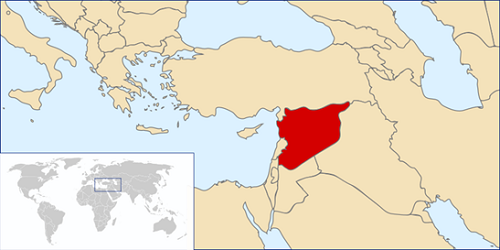
Geography

Source: This image is the intellectual property of Rei-artur. Redistribution under licence CC BY-SA 3.0
Area: 185,180 km2 (0,84% water)
Coastline: 193 km
Terrain: Narrow coastal plain, semi-arid and desert plateau, mountains mainly to the west and in the central part of the country
Highest point: Mount Hermon 2,814 m (on the Lebanon border)
Climate: Desert climate in most of the country. In the coastal areas the summers are hot and dry while winters are mild and wet. In Damascus the climate is cooler, periodic snowfalls
Geographical population distribution: Most of the population is concentrated in the western half of the country, especially in the northwest. About 20% of the population lives in Aleppo and Damascus. The east and southeast parts of country are sparsely populated
Natural resources: petroleum, phosphates, chrome and manganese ores, asphalt, iron ore, rock salt, marble, gypsum, hydropower
Demographics
Population: 17,500,660 (2020)Annual population growth: 2.5% (2020)
Population estimate in 2025: 23,062,000
Population distribution by age group (2020)0-14 – 31%
15-64 – 64%
65+ – 5%
Fertility rate (births per woman): 2.8 (2019)
Birth rate (births per 1000 people): 23 (2019)
Death rate (deaths per 1000 people): 5 (2019)
Median age: 23.6 years (2015)
Life expectancy (at birth): 73 years (2019)Males – 68 years
Females – 78 years
Net migration: -2,137,000 people (2017)
Language: Arabic is the official language of Syria
Religious groups: Sunni Muslims 78.5%, Shia Muslims (mainly Alawites) 13.9%, Greek Orthodox Christians 2.6%, Other Christians 2.3%, Non-religious/atheists 1.9%, Other Muslims 0.7%, Other religions 0.1% (2015)
Ethnic groups: Arabs 88.3%, Kurds 8.4%, Armenians 1.6%, Others 1.7% (2013)
Economy
GDP: $22.78 bil (2019)
GDP per capita: $1,334.4 (2019)
GDP annual growth rate: 3.7% (2019)
Public debt (% GDP): 30.0% (2010)
Inflation (CPI): 36.7% (2012)
Unemployment: 9.0% (2020)
Imports: $4,400,000,000 (2017)10 largest import partners (% total imports - 2017): Turkey 26%, China 25%, Lebanon 5.6%, Egypt 4.9%, South Korea 4.9%, Russia 4.3%, India 3.3%, Italy 2.4%, Germany 2.0%, Brazil 1.7%
Exports: $29,383,961,546 (2018)10 largest export partners (% total exports - 2017): Lebanon 21.0%, Egypt 17.0%, Turkey 11.0%, Jordan 11.0%, Spain 8.6%, Algeria 5.3%, India 4.6%, Kuwait 3.3%, Germany 3.0%, Italy 1.3%
Global Competitiveness Report (World Economic Forum)- Index of Economic Freedom (Heritage Foundation)
- Income Inequality Index (Gini – World Bank)
35.8% (2013) Prosperity Index (Legatum Institute)
37.66/100 (2021 – position 158/167)
Military Power
Active troops: 300,000 (2011)Army: 200-225,000
Defence expenditure: 4.1 (2010)
Politics and Government
Form of government: Semi-presidential
President: Bashar al-Assad (2000)Prime Minister: Hussein Arnous (2020)
Executive branch: Based on the constitution of Syria that was approved by referendum in 2012, executive power is exercised by the President and the Prime Minister. The President holds powers that are usually held by presidents in presidential systems while the Prime Minister is head of government. The President is head of state, chief of the armed forces and he is elected for a 7-year term, having the right to serve up to two consecutive terms. The Prime Minister and the Ministers are appointed by the President.
Legislative branch: The People’s Council is the legislative authority of Syria, it consists of 250 members, elected directly by citizens for a 4-year term and at least half of them must come from the workers and farmers. Among other duties, the People’s Council recommends legislation and submits questions to the government, approves laws and the general budge. The People’s Council can also initiate a vote of confidence in the government or Ministers.
Judicial branch: The Supreme Judicial Council supervises the court system and it is headed by the President of the Republic who guarantees the independence of the judiciary. The Court of Cassation is the country’s highest court and it is divided in civil, criminal, military, religious and other courts. The Constitutional Court makes decisions concerning the constitutionality of laws. A law that is approved by referendum cannot be deemed unconstitutional. The Minister of Justice is head of the General Prosecutor’s Office.
Parliamentary parties (seats): Ba’ath Party (167), Syrian Social Nationalist Party (3), Syrian Communist Party (Bakdash) (3), Socialist Unionist Party (2), Arab Socialist Union Party (3), Syrian Communist Party (Faisal) (1), National Covenant Party (2), Arabic Democratic Union Party (1), Democratic Socialist Unionist Party (1), Independents (67)
Last elections: Local elections 2018 – Overwhelming dominance of the Ba’ath party. The elections were not competitive at all and voter turnout was 26.5%Next elections: Parliamentary elections in spring 2024
Rule of Law - Human Rights
Corruption Perceptions Index (Transparency International)14/100 (2020 - position 178/180) Rule of Law Index (World Justice Project)
- Global Terrorism Index (Institute for Economics & Peace)
8.006/10 (2019 – position 4/163) Fragile States Index (Fund For Peace)
110.7/120 (2021 – position 3/179) Democracy Index (Economist Intelligence Unit)
1.43/10 (2020 – θέση 164/167) Press Freedom Index (Reporters Without Borders)
70.63/100 (2021 – position 173/180) Freedom in the World Index (Freedom House)
0/100 (2021)




